Bell Labs
Nokia Bell Labs, originally named Bell Telephone Laboratories (1925–1984),[1] then AT&T Bell Laboratories (1984–1996)[2] and Bell Labs Innovations (1996–2007),[3] is an American industrial research and scientific development company owned by Finnish company Nokia. It is headquartered in Murray Hill, New Jersey, and operates a global network of laboratories.
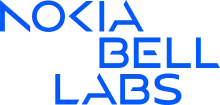 Logo since 2023 | |
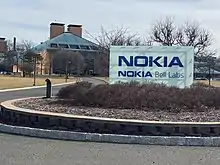 Headquarters in Murray Hill, New Jersey, formerly the corporate headquarters of Lucent | |
| Type | Subsidiary |
|---|---|
| Industry | Telecommunication, information technology, material science |
| Founded | January 1925 (as Bell Telephone Laboratories, Inc.) |
| Headquarters | Murray Hill, New Jersey, U.S. |
Key people | Peter Vetter, Thierry Klein |
| Parent | AT&T Corporation (1925–1996) Western Electric (1925–1983) Lucent (1996–2006) Alcatel-Lucent (2006–2016) Nokia (2016–present) |
| Subsidiaries | Nokia Shanghai Bell |
| Website | www |
Researchers working at Bell Laboratories are credited with the development of radio astronomy, the transistor, the laser, the photovoltaic cell, the charge-coupled device (CCD), information theory, the Unix operating system, and the programming languages B, C, C++, S, SNOBOL, AWK, AMPL, and others. Ten Nobel Prizes have been awarded for work completed at Bell Laboratories.[4]
Bell Labs had its origin in the complex corporate organization of the Bell System telephone conglomerate. The laboratory began in the late 19th century as the Western Electric Engineering Department, located at 463 West Street in New York City. After years of conducting research and development under Western Electric, a Bell subsidiary, the Engineering Department was reformed into Bell Telephone Laboratories in 1925 and placed under the shared ownership of Western Electric and the American Telephone and Telegraph Company (AT&T). In the 1960s, laboratory and company headquarters were moved to New Jersey. Nokia acquired Bell Labs in 2016.
Origin and historical locations
Bell's personal research after the telephone
In 1880, when the French government awarded Alexander Graham Bell the Volta Prize of 50,000 francs for the invention of the telephone (equivalent to about US$10,000 at the time, or about $310,000 now),[5] he used the award to fund the Volta Laboratory (also known as the "Alexander Graham Bell Laboratory") in Washington, D.C. in collaboration with Sumner Tainter and Bell's cousin Chichester Bell.[6] The laboratory was variously known as the Volta Bureau, the Bell Carriage House, the Bell Laboratory and the Volta Laboratory.
It focused on the analysis, recording, and transmission of sound. Bell used his considerable profits from the laboratory for further research and education advancing the diffusion of knowledge relating to the deaf.[6] This resulted in the founding of the Volta Bureau (c. 1887) at the Washington, D.C. home of his father, linguist Alexander Melville Bell. The carriage house there, at 1527 35th Street N.W., became their headquarters in 1889.[6]
In 1893, Bell constructed a new building close by at 1537 35th Street N.W., specifically to house the lab.[6] This building was declared a National Historic Landmark in 1972.[7][8][9]
After the invention of the telephone, Bell maintained a relatively distant role with the Bell System as a whole, but continued to pursue his own personal research interests.[10]

Early antecedent
The Bell Patent Association was formed by Alexander Graham Bell, Thomas Sanders, and Gardiner Hubbard when filing the first patents for the telephone in 1876.
Bell Telephone Company, the first telephone company, was formed a year later. It later became a part of the American Bell Telephone Company.
In 1884, the American Bell Telephone Company created the Mechanical Department from the Electrical and Patent Department formed a year earlier.
American Telephone & Telegraph Company (AT&T) and its own subsidiary company, took control of American Bell and the Bell System by 1889.
American Bell held a controlling interest in Western Electric (which was the manufacturing arm of the business) whereas AT&T was doing research into the service providers.[11][12]
Formal organization and location changes
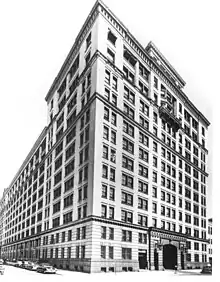
In 1896, Western Electric bought property at 463 West Street to centralize the manufacturers and engineers which had been supplying AT&T with such technology as telephones, telephone exchange switches and transmission equipment.
On January 1, 1925, Bell Telephone Laboratories, Inc. was organized to consolidate the development and research activities in the communication field and allied sciences for the Bell System. Ownership was evenly shared between Western Electric and AT&T. The new company had 3600 engineers, scientists, and support staff. Its 400,000 square foot space was expanded with a new building occupying about one quarter of a city block.[13]
The first chairman of the board of directors was John J. Carty, the vice-president of AT&T, and the first president was Frank B. Jewett,[13] also a board member, who stayed there until 1940.[14][15][16] The operations were directed by E. B. Craft, executive vice-president, and formerly chief engineer at Western Electric.
By the early 1940s, Bell Labs engineers and scientists had begun to move to other locations away from the congestion and environmental distractions of New York City, and in 1967 Bell Laboratories headquarters was officially relocated to Murray Hill, New Jersey.
Among the later Bell Laboratories locations in New Jersey were Holmdel, Crawford Hill, the Deal Test Site, Freehold, Lincroft, Long Branch, Middletown, Neptune, Princeton, Piscataway, Red Bank, Chester, and Whippany. Of these, Murray Hill and Crawford Hill remain in existence (the Piscataway and Red Bank locations were transferred to and are now operated by Telcordia Technologies and the Whippany site was purchased by Bayer[17]).
The largest grouping of people in the company was in Illinois, at Naperville-Lisle, in the Chicago area, which had the largest concentration of employees (about 11,000) prior to 2001. There also were groups of employees in Indianapolis, Indiana; Columbus, Ohio; North Andover, Massachusetts; Allentown, Pennsylvania; Reading, Pennsylvania; and Breinigsville, Pennsylvania; Burlington, North Carolina (1950s–1970s, moved to Greensboro 1980s) and Westminster, Colorado. Since 2001, many of the former locations have been scaled down or closed.

Bell’s Holmdel research and development lab, a 1.9 million square foot structure set on 473 acres, was closed in 2007. The mirrored-glass building was designed by Eero Saarinen. In August 2013, Somerset Development bought the building, intending to redevelop it into a mixed commercial and residential project. A 2012 article expressed doubt on the success of the newly named Bell Works site,[18] but several large tenants had announced plans to move in through 2016 and 2017.[19][20]
Building Complex Location (code) information, past and present
- Chester (CH) - North Road, Chester, NJ (began 1930, outdoor test site for small size telephone pole preservation, timber-related equipment, cable laying mechanism for the first undersea voice cable, research for loop transmission, Lucent donated land for park)[21]
- Crawford Hill (HOH) - Crawfords Corner Road, Holmdel, NJ (built 1930s, currently as exhibit and building sold, horn antenna used for "Big Bang" theory)
- Red Hill (HR) - located at exit 109 on the Garden State Parkway (480 Red Hill Rd, Middletown, NJ), the building that formerly housed hundreds of Bell Labs researchers is now in use by Memorial Sloan Kettering
- Holmdel (HO) - 101 Crawfords Corner, Holmdel, NJ (built 1959–1962, older structures in the 1920s, currently as private building called Bell Works, discovered extraterrestrial radio emissions, undersea cable research, satellite transmissions systems Telstar 3 and 4); provided office space for ~3000 workers in the 1980s; prized glass building with hollow interior designed by Eero Saarinen; a 3-legged white water tower built to resemble a transistor marks the long entrance drive to this facility
- Indian Hill (IH) - 2000 Naperville Road, Naperville, IL (built 1966, currently Nokia, developed switching technology and systems)[22]
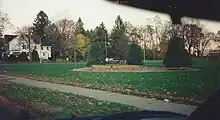
- Murray Hill (MH) - 600 Mountain Ave, Murray Hill, NJ (built 1941–1945, currently Nokia, developed transistor, UNIX operating system and C programming language, anechoic chamber, several building sections demolished)
- Short Hills (HL) - 101-103 JFK Parkway, Short Hills, NJ (Various departments such as Accounts Payable, IT Purchasing, HR Personnel, Payroll, Telecom, and the Government group, and Unix Administration Systems Computer Center. Buildings exist without the overhead walkway between the two buildings and two different companies are located from banking and business analytics.)
- Summit (SF) - 190 River Road, Summit, NJ (building was part of the UNIX Software Operations and became UNIX System Laboratories, Inc. In December 1991, USL combined with Novell. Location is a banking company.)
- West St ( ) - 463 West Street, New York, NY (built 1898, 1925 until December 1966 as Bell Labs headquarters, experimental talking movies, wave nature of matter, radar)
- Whippany (WH) - 67 Whippany Road, Whippany, NJ (built 1920s, demolished and portion building as Bayer, performed military research and development, research and development in radar, in guidance for the Nike missile, and in underwater sound, Telstar 1, wireless technologies)[22]
List of Bell Labs (1974)
Bell Lab’s 1974 corporate directory listed 22 labs in the United States, located in:
- Allentown - Allentown, PA
- Atlanta - Norcross, GA
- Centennial Park - Piscataway, NJ
- Chester - Chester, NJ
- Columbus - Columbus, OH
- Crawford Hill - Holmdel, NJ
- Denver - Denver, CO
- Grand Forks-MSR - Cavalier, ND [Missile Site Radar (MSR) Site]
- Grand Forks-PAR - Cavalier, ND [Perimeter Acquisition Radar (PAR) Site]
- Guilford Center - Greensboro, NC
- Holmdel - Holmdel, NJ
- Indianapolis - Indianapolis, IN
- Indian Hill - Naperville, IL
- Kwajalein - San Francisco, CA
- Madison - Madison, NJ
- Merrimack Valley - North Andover, MA
- Murray Hill - Murray Hill, NJ
- Raritan River Center - Piscataway, NJ
- Reading - Reading, PA
- Union - Union, NJ
- Warren Service Center - Warren, NJ
- Whippany - Whippany, NJ
Discoveries and developments
Bell Laboratories was, and is, regarded by many as the premier research facility of its type, developing a wide range of revolutionary technologies, including radio astronomy, the transistor, the laser, information theory, the operating system Unix, the programming languages C and C++, solar cells, the charge-coupled device (CCD), and many other optical, wireless, and wired communications technologies and systems.
1920s
In 1924, Bell Labs physicist Walter A. Shewhart proposed the control chart as a method to determine when a process was in a state of statistical control. Shewhart's methods were the basis for statistical process control (SPC): the use of statistically based tools and techniques to manage and improve processes. This was the origin of the modern quality control movement, including Six Sigma.
In 1926, the laboratories invented an early synchronous-sound motion picture system, in competition with Fox Movietone and DeForest Phonofilm.[23]
In 1927, a Bell team headed by Herbert E. Ives successfully transmitted long-distance 128-line television images of Secretary of Commerce Herbert Hoover from Washington to New York. In 1928 the thermal noise in a resistor was first measured by John B. Johnson, for which Harry Nyquist provided the theoretical analysis; this is now termed Johnson noise. During the 1920s, the one-time pad cipher was invented by Gilbert Vernam and Joseph Mauborgne at the laboratories. Bell Labs' Claude Shannon later proved that it is unbreakable.
In 1928, Harold Black invented the negative feedback system commonly used in amplifiers. Later, Harry Nyquist analyzed Black's design rule for negative feedback. This work was published in 1932 and became known as the Nyquist criterion.
1930s
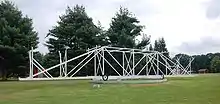
In 1931, a foundation for radio astronomy was laid by Karl Jansky during his work investigating the origins of static on long-distance shortwave communications. He discovered that radio waves were being emitted from the center of the galaxy.
In 1931 and 1932, the labs made experimental high fidelity, long playing, and even stereophonic recordings of the Philadelphia Orchestra, conducted by Leopold Stokowski.[24]
In 1933, stereo signals were transmitted live from Philadelphia to Washington, D.C.
In 1937, the vocoder, an electronic speech compression device, or codec, and the Voder, the first electronic speech synthesizer, were developed and demonstrated by Homer Dudley, the Voder being demonstrated at the 1939 New York World's Fair. Bell researcher Clinton Davisson shared the Nobel Prize in Physics with George Paget Thomson for the discovery of electron diffraction, which helped lay the foundation for solid-state electronics.
1940s

In the early 1940s, the photovoltaic cell was developed by Russell Ohl. In 1943, Bell developed SIGSALY, the first digital scrambled speech transmission system, used by the Allies in World War II. The British wartime codebreaker Alan Turing visited the labs at this time, working on speech encryption and meeting Claude Shannon.[25]
Bell Labs Quality Assurance Department gave the world and the United States such statisticians as Walter A. Shewhart, W. Edwards Deming, Harold F. Dodge, George D. Edwards, Harry Romig, R. L. Jones, Paul Olmstead, E.G.D. Paterson, and Mary N. Torrey. During World War II, Emergency Technical Committee – Quality Control, drawn mainly from Bell Labs' statisticians, was instrumental in advancing Army and Navy ammunition acceptance and material sampling procedures.
In 1947, the transistor, arguably the most important invention developed by Bell Laboratories, was invented by John Bardeen, Walter Houser Brattain, and William Bradford Shockley (and who subsequently shared the Nobel Prize in Physics in 1956). In 1947, Richard Hamming invented Hamming codes for error detection and correction. For patent reasons, the result was not published until 1950.
In 1948, "A Mathematical Theory of Communication", one of the founding works in information theory, was published by Claude Shannon in the Bell System Technical Journal. It built in part on earlier work in the field by Bell researchers Harry Nyquist and Ralph Hartley, but it greatly extended these. Bell Labs also introduced a series of increasingly complex calculators through the decade. Shannon was also the founder of modern cryptography with his 1949 paper Communication Theory of Secrecy Systems.
Calculators
- Model I: A complex number calculator, completed in 1939 and put into operation in 1940, for doing calculations of complex numbers.
- Model II: Relay Computer / Relay Interpolator,[28] September 1943, for interpolating data points of flight profiles (needed for performance testing of a gun director).[29] This model introduced error detection (self checking).[30][31]
- Model III: Ballistic Computer,[32][33] June 1944, for calculations of ballistic trajectories
- Model IV: Error Detector Mark II, March 1945,[34] improved ballistic computer
- Model V:[35] General-purpose electromechanical computer, of which two were built, July 1946 and February 1947[36][34][37]
- Model VI: 1949, an enhanced Model V
1950s
The 1950s also saw developments based upon information theory. The central development was binary code systems. Efforts concentrated on the prime mission of supporting the Bell System with engineering advances, including the N-carrier system, TD microwave radio relay, direct distance dialing, E-repeater, wire spring relay, and the Number Five Crossbar Switching System.
In 1952, William Gardner Pfann revealed the method of zone melting, which enabled semiconductor purification and level doping.
In 1953, Maurice Karnaugh developed the Karnaugh map, used for managing of Boolean algebraic expressions.
In 1954, the first modern solar cell was invented at Bell Laboratories.
In 1956 TAT-1, the first transatlantic communications cable to carry telephone conversations, was laid between Scotland and Newfoundland in a joint effort by AT&T, Bell Laboratories, and British and Canadian telephone companies.
In 1957, Max Mathews created MUSIC, one of the first computer programs to play electronic music. Robert C. Prim and Joseph Kruskal developed new greedy algorithms that revolutionized computer network design.
In 1958, a technical paper by Arthur Schawlow and Charles Hard Townes first described the laser.
In 1959, Mohamed M. Atalla and Dawon Kahng invented the metal-oxide semiconductor field-effect transistor (MOSFET).[38] The MOSFET has achieved electronic hegemony and sustains the large-scale integration (LSI) of circuits underlying today's information society.
1960s

On October 1, 1960, the Kwajalein Field Station was announced as a location for the NIKE-ZEUS test program. Mr. R. W. Benfer was the first director to arrive shortly on October 5 for the program. Bell Labs designed many of the major system elements and conducted fundamental investigations of phase-controlled scanning antenna arrays.[39]
In December 1960, Ali Javan, PhD physicist from the university of Teheran, Iran with help by Rolf Seebach and his associates William Bennett and Donald Heriot, successfully operated the first gas laser, the first continuous-light laser, operating at an unprecedented accuracy and color purity.
In 1962, the electret microphone was invented by Gerhard M. Sessler and James E. West. Also in 1962, John R. Pierce's vision of communications satellites was realized by the launch of Telstar.
On July 10, 1962, the Telstar spacecraft was launched into orbit by NASA and it was designed and built by Bell Laboratories. The first worldwide television broadcast was July 23, 1962 with a press conference by President Kennedy.[40]
In Spring 1964, the building of an electronic switching systems center was planned at Bell Laboratories near Naperville, Illinois. The building in 1966 would be called Indian Hill, and development work from former electronic switching organization at Holmdel and Systems Equipment Engineering organization would occupy the laboratory with engineers from Western Electric Hawthorne Works. Scheduled for work were about 1,200 people when completed in 1966, and peaked at 11,000 before October 2001 Lucent Technologies downsizing occurred.[41]
In 1964, the carbon dioxide laser was invented by Kumar Patel and the discovery/operation of the Nd:YAG laser was demonstrated by J.E. Geusic et al. Experiments by Myriam Sarachik provided the first data that confirmed the Kondo effect.[42] The research of Philip W. Anderson into electronic structure of magnetic and disordered systems led to improved understanding of metals and insulators for which he was awarded the Nobel Prize for Physics in 1977.[43] In 1965, Penzias and Wilson discovered the cosmic microwave background, for which they were awarded the Nobel Prize in Physics in 1978.[44]
Frank W. Sinden, Edward E. Zajac, Ken Knowlton, and A. Michael Noll made computer-animated movies during the early to mid-1960s. Ken Knowlton invented the computer animation language BEFLIX. The first digital computer art was created in 1962 by Noll.
In 1966, orthogonal frequency-division multiplexing (OFDM), a key technology in wireless services, was developed and patented by R. W. Chang.
In December 1966, the New York City site was sold and became the Westbeth Artists Community complex.
In 1968, molecular beam epitaxy was developed by J.R. Arthur and A.Y. Cho; molecular beam epitaxy allows semiconductor chips and laser matrices to be manufactured one atomic layer at a time.
In 1969, Dennis Ritchie and Ken Thompson created the computer operating system UNIX for the support of telecommunication switching systems as well as general-purpose computing. Also, in 1969, the charge-coupled device (CCD) was invented by Willard Boyle and George E. Smith, for which they were awarded the Nobel Prize in Physics in 2009.
From 1969 to 1971, Aaron Marcus, the first graphic designer involved with computer graphics, researched, designed, and programmed a prototype interactive page-layout system for the Picturephone.
1970s
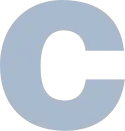
The 1970s and 1980s saw more and more computer-related inventions at the Bell Laboratories as part of the personal computing revolution.
In the 1970s, major central office technology evolved from crossbar electromechanical relay-based technology and discrete transistor logic to Bell Labs-developed thick film hybrid and transistor–transistor logic (TTL), stored program-controlled switching systems; 1A/#4 TOLL Electronic Switching Systems (ESS) and 2A Local Central Offices produced at the Bell Labs Naperville and Western Electric Lisle, Illinois facilities. This technology evolution dramatically reduced floor space needs. The new ESS also came with its own diagnostic software that needed only a switchman and several frame technicians to maintain.
About 1970, the coax-22 cable was developed by Bell Labs. This coax cable with 22 strands allowed a total capacity of 132,000 telephone calls. Previously, a 12-strand coax cable was used for L-carrier systems. Both of these types of cables were manufactured at Western Electrics' Baltimore Works facility on machines designed by a Western Electric Senior development engineer.[45]
In 1970, A. Michael Noll invented a tactile, force-feedback system, coupled with interactive stereoscopic computer display.
In 1971, an improved task priority system for computerized telephone exchange switching systems for telephone traffic was invented by Erna Schneider Hoover, who received one of the first software patents for it.
In 1972, Dennis Ritchie developed the compiled programming language C as a replacement for the interpreted language B, which was then used in a worse is better rewrite of UNIX. Also, the language AWK was designed and implemented by Alfred Aho, Peter Weinberger, and Brian Kernighan of Bell Laboratories. Also in 1972, Marc Rochkind invented the Source Code Control System.
In 1976, optical fiber systems were first tested in Georgia.
Production of their first internally-designed microprocessor, the BELLMAC-8, began in 1977. In 1980 they demonstrated the first single-chip 32-bit microprocessor, the Bellmac 32A, which went into production in 1982.
In 1978, the proprietary operating system Oryx/Pecos was developed from scratch by Bell Labs in order to run AT&T's large-scale PBX switching equipment. It was first used with AT&T's flagship System 75, and until very recently, was used in all variations up through and including Definity G3 (Generic 3) switches, now manufactured by AT&T/Lucent Technologies spin off Avaya.
1980s

During the 1980s, the operating system Plan 9 from Bell Labs was developed extending the UNIX model. Also, the Radiodrum, an electronic music instrument played in three space dimensions, was invented.
In 1980, the TDMA digital cellular telephone technology was patented.
The launching of the Bell Labs Fellows Award started in 1982 to recognize and honor scientists and engineers who have made outstanding and sustained R&D contributions at AT&T with a level of distinction. As of the 2021 inductees, only 336 people have received the honor.[46]
Ken Thompson and Dennis Ritchie were also Bell Labs Fellows for 1982. Ritchie started in 1967 at Bell Labs in the Bell Labs Computer Systems Research department.[47] Thompson started in 1966. Both co-inventors of the UNIX operating system and C language were also awarded decades later the 2011 Japan Prize for Information and Communications.
In 1982, fractional quantum Hall effect was discovered by Horst Störmer and former Bell Laboratories researchers Robert B. Laughlin and Daniel C. Tsui; they consequently won a Nobel Prize in 1998 for the discovery.
In 1984, the first photoconductive antennas for picosecond electromagnetic radiation were demonstrated by Auston and others. This type of antenna became an important component in terahertz time-domain spectroscopy. In 1984, Karmarkar's algorithm for linear programming was developed by mathematician Narendra Karmarkar. Also in 1984, a divestiture agreement signed in 1982 with the American Federal government forced the breakup of AT&T, and Bellcore (now iconectiv) was split off from Bell Laboratories to provide the same R&D functions for the newly created local exchange carriers. AT&T also was limited to using the Bell trademark only in association with Bell Laboratories. Bell Telephone Laboratories, Inc. became a wholly owned company of the new AT&T Technologies unit, the former Western Electric. The 5ESS Switch was developed during this transition.
The National Medal of Technology was awarded to Bell Labs, the first corporation to achieve this honor in February 1985.[48]
In 1985, laser cooling was used to slow and manipulate atoms by Steven Chu and team. In 1985, the modeling language A Mathematical Programming Language, AMPL, was developed by Robert Fourer, David M. Gay and Brian Kernighan at Bell Laboratories. Also in 1985, Bell Laboratories was awarded the National Medal of Technology "For contribution over decades to modern communication systems".
In 1985,[49] the programming language C++ had its first commercial release.[50] Bjarne Stroustrup started developing C++ at Bell Laboratories in 1979 as an extension to the original C language.[50]
Arthur Ashkin invented optical tweezers that grab particles, atoms, viruses and other living cells with their laser beam fingers. A major breakthrough came in 1987, when Ashkin used the tweezers to capture living bacteria without harming them. He immediately began studying biological systems using the optical tweezers, which are now widely used to investigate the machinery of life.[51] He was awarded the Nobel Prize in Physics (2018) for his work involving optical tweezers and their application to biological systems.
In the mid-1980s, the transmission departments of Bell Labs developed highly reliable long-haul fiber-optic communications systems based on SONET, and network operations techniques, that enabled very high volume, near-instantaneous communications across the North American continent. Fail-safe and disaster-related traffic management operations systems enhanced the usefulness of the fiber optics. There was a synergy in the land-based and seas-based fiber optic systems, although they were developed by different divisions within the company. These systems are still in use throughout the U.S. today.
Charles A. Burrus became a Bell Labs Fellow in 1988 for his work done as a Technical Staff member. Prior to this accomplishment, was awarded in 1982 the AT&T Bell Laboratories Distinguished Technical Staff Award. Charles started in 1955 at the Holmdel Bell Labs location and retired in 1996 with consultations to Lucent Technologies up to 2002.[52]
In 1988, TAT-8 became the first transatlantic fiber-optic cable. Bell Labs in Freehold, NJ developed the 1.3-micron fiber, cable, splicing, laser detector, and 280 Mbit/s repeater for 40,000 telephone-call capacity.
In the late 1980s, realizing that voiceband modems were approaching the Shannon limit on bit rate, Richard D. Gitlin, Jean-Jacques Werner, and their colleagues pioneered a major breakthrough by inventing DSL (Digital Subscriber Line) and creating the technology that enabled megabit transmission on installed copper telephone lines, thus facilitating the broadband era.[53]
1990s

Bell Labs' John Mayo received the National Medal of Technology in 1990.[54]
In May 1990, Ronald Snare was named AT&T Bell Laboratories Fellow, for “Singular contributions to the development of the common-channel signaling network and the signal transfer points globally.” This system began service in the United States in 1978.[55]
In the early 1990s, approaches to increase modem speeds to 56K were explored at Bell Labs, and early patents were filed in 1992 by Ender Ayanoglu, Nuri R. Dagdeviren and their colleagues.[56]
The scientist, W. Lincoln Hawkins in 1992 received the National Medal of Technology for work done at Bell Labs.[54]
In 1992, Jack Salz, Jack Winters and Richard D. Gitlin provided the foundational technology to demonstrate that adaptive antenna arrays at the transmitter and receiver can substantially increase both the reliability (via diversity) and capacity (via spatial multiplexing) of wireless systems without expanding the bandwidth.[57] Subsequently, the BLAST system proposed by Gerard Foschini and colleagues dramatically expanded the capacity of wireless systems.[58] This technology, known today as MIMO (Multiple Input Multiple Output), was a significant factor in the standardization, commercialization, performance improvement, and growth of cellular and wireless LAN systems.
Amos Joel in 1993 received the National Medal of Technology.[54]
Two AT&T Bell Labs scientists, Joel Engel and Richard Frenkiel, were honored with the National Medal of Technology, in 1994.[54]
In 1994, the quantum cascade laser was invented by Federico Capasso, Alfred Cho, Jerome Faist and their collaborators. Also in 1994, Peter Shor devised his quantum factorization algorithm.
In 1996, SCALPEL electron lithography, which prints features atoms wide on microchips, was invented by Lloyd Harriott and his team. The operating system Inferno, an update of Plan 9, was created by Dennis Ritchie with others, using the then-new concurrent programming language Limbo. A high performance database engine (Dali) was developed which became DataBlitz in its product form.[59]
In 1996, AT&T spun off Bell Laboratories, along with most of its equipment manufacturing business, into a new company named Lucent Technologies. AT&T retained a small number of researchers who made up the staff of the newly created AT&T Labs.
Lucy Sanders was the third woman to receive the Bell Labs Fellow award in 1996, for her work in creating a RISC chip that allowed more phone calls using software and hardware on a single server. She started in 1977 and was one of the few woman engineers at Bell Labs.[60]
In 1997, the smallest then-practical transistor (60 nanometers, 182 atoms wide) was built. In 1998, the first optical router was invented.
Rudolph Kazarinov and Federico Capasso received the optoelectronics Rank Prize on December 8, 1998.[54]
In December 1998, Ritchie and Thompson also were honorees of the National Medal of Technology for their work done for pre-Lucent Technologies Bell Labs. The award was presented by U.S. President William Clinton in 1999 in a White House ceremony.[54]
2000s
2000 was an active year for the Laboratories, in which DNA machine prototypes were developed; progressive geometry compression algorithm made widespread 3-D communication practical; the first electrically powered organic laser was invented; a large-scale map of cosmic dark matter was compiled; and the F-15 (material), an organic material that makes plastic transistors possible, was invented.
In 2002, physicist Jan Hendrik Schön was fired after his work was found to contain fraudulent data. It was the first known case of fraud at Bell Labs.
In 2003, the New Jersey Institute of Technology Biomedical Engineering Laboratory was created at Murray Hill, New Jersey.[61]
In 2004, Lucent Technologies awarded two women the prestigious Bell Labs Fellow Award. Magaly Spector, a director in INS/Network Systems Group, was awarded for "sustained and exceptional scientific and technological contributions in solid-state physics, III-V material for semiconductor lasers, Gallium Arsenide integrated circuits, and the quality and reliability of products used in high speed optical transport systems for next generation high bandwidth communication." Eve Varma, a technical manager in MNS/Network Systems Group, was awarded for her citation in "sustained contributions to digital and optical networking, including architecture, synchronization, restoration, standards, operations and control."
In 2005, Jeong H. Kim, former President of Lucent's Optical Network Group, returned from academia to become the President of Bell Laboratories.
In April 2006, Bell Laboratories' parent company, Lucent Technologies, signed a merger agreement with Alcatel. On December 1, 2006, the merged company, Alcatel-Lucent, began operations. This deal raised concerns in the United States, where Bell Laboratories works on defense contracts. A separate company, LGS Innovations, with an American board was set up to manage Bell Laboratories' and Lucent's sensitive U.S. government contracts. In March 2019, LGS Innovations was purchased by CACI.[62]
In December 2007, it was announced that the former Lucent Bell Laboratories and the former Alcatel Research and Innovation would be merged into one organization under the name of Bell Laboratories. This is the first period of growth following many years during which Bell Laboratories progressively lost manpower due to layoffs and spin-offs making the company shut down briefly.
In February 2008, Alcatel-Lucent continued the Bell Laboratories tradition of awarding the prestigious award for outstanding technical contributors. Martin J. Glapa, a former chief Technical Officer of Lucent's Cable Communications Business Unit and Director of Advanced Technologies,[63] was presented by Alcatel-Lucent Bell Labs President Jeong H. Kim with the 2006 Bell Labs Fellow Award in Network Architecture, Network Planning, and Professional Services with particular focus in Cable TV Systems and Broadband Services having "significant resulting Alcatel-Lucent commercial successes." Glapa is a patent holder and has co-written the 2004 technical paper called "Optimal Availability & Security For Voice Over Cable Networks" and co-authored the 2008 "Impact of bandwidth demand growth on HFC networks" published by IEEE.[64]
As of July 2008, however, only four scientists remained in physics research, according to a report by the scientific journal Nature.[65]
On August 28, 2008, Alcatel-Lucent announced it was pulling out of basic science, material physics, and semiconductor research, and it will instead focus on more immediately marketable areas, including networking, high-speed electronics, wireless networks, nanotechnology and software.[66]
In 2009, Willard Boyle and George Smith were awarded the Nobel Prize in Physics for the invention and development of the charge-coupled device (CCD).[67]
Rob Soni was an Alcatel-Lucent Bell Labs Fellow in 2009 as cited for work in winning North American customers wireless business and for helping to define 4G wireless networks with transformative system architectures.[68]
2010s
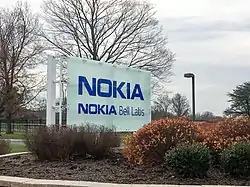
Gee Rittenhouse, former Head of Research, returned from his position as chief operating officer of Alcatel-Lucent's Software, Services, and Solutions business in February 2013, to become the 12th President of Bell Labs.[69]
On November 4, 2013, Alcatel-Lucent announced the appointment of Marcus Weldon as President of Bell Labs. His stated charter was to return Bell Labs to the forefront of innovation in Information and communications technology by focusing on solving the key industry challenges, as was the case in the great Bell Labs innovation eras in the past.[70]
In July 2014, Bell Labs announced it had broken "the broadband Internet speed record" with a new technology dubbed XG-FAST that promises 10 gigabits per second transmission speeds.[71]
In 2014, Eric Betzig shared the Nobel Prize in Chemistry for his work in super-resolved fluorescence microscopy which he began pursuing while at Bell Labs in the Semiconductor Physics Research Department.[72]
On April 15, 2015, Nokia agreed to acquire Alcatel-Lucent, Bell Labs' parent company, in a share exchange worth $16.6 billion.[73][74] Their first day of combined operations was January 14, 2016.[75]
In September 2016, Nokia Bell Labs, along with Technische Universität Berlin, Deutsche Telekom T-Labs and the Technical University of Munich achieved a data rate of one terabit per second by improving transmission capacity and spectral efficiency in an optical communications field trial with a new modulation technique.[76]
Antero Taivalsaari became a Bell Labs Fellow in 2016 for his specific work.[77]
In 2017, Dragan Samardzija was awarded the Bell Labs Fellow.[78]
In 2018, Arthur Ashkin shared the Nobel Prize in Physics for his work on "the optical tweezers and their application to biological systems"[51] which was developed at Bell Labs in the 1980s.
2020s
In 2020, Alfred Aho and Jeffrey Ullman shared the Turing Award for their work on compilers, starting with their tenure at Bell Labs during 1967–69.
On, November 16, 2021, Nokia presented the 2021 Bell Labs Fellows Award Ceremony, six new members (Igor Curcio, Matthew Andrews, Bjorn Jelonnek, Ed Harstead, Gino Dion, Esa Tiirola) held at Nokia Batvik Mansion, Finland.[79]
In December 2021, Nokia's Chief Strategy and Technology Officer decided to reorganize Bell Labs in two separate functional organizations: Bell Labs Core Research and Bell Labs Solutions research. Bell Labs Core Research is in charge of creating disruptive technologies with 10-year horizon. Bell Labs Solutions Research, looks for shorter term solutions that can provide growth opportunities for Nokia.[80]
The Nokia 2022 Bell Labs Fellows were recognized on November 29, 2022, in a New Jersey ceremony. Five researchers were inducted to the total of 341 recipients since its inception by AT&T Bell Labs in 1982. One member was from New Jersey, two were from Cambridge, UK, and two were from Finland representing Espoo and Tampere locations.[81]
Nobel Prize, Turing Award, IEEE Medal of Honor
Ten Nobel Prizes have been awarded for work completed at Bell Laboratories.[82]
- 1937: Clinton J. Davisson shared the Nobel Prize in Physics for demonstrating the wave nature of matter.
- 1956: John Bardeen, Walter H. Brattain, and William Shockley received the Nobel Prize in Physics for inventing the first transistors.
- 1977: Philip W. Anderson shared the Nobel Prize in Physics for developing an improved understanding of the electronic structure of glass and magnetic materials.
- 1978: Arno A. Penzias and Robert W. Wilson shared the Nobel Prize in Physics. Penzias and Wilson were cited for their discovering cosmic microwave background radiation, a nearly uniform glow that fills the Universe in the microwave band of the radio spectrum.
- 1997: Steven Chu shared the Nobel Prize in Physics for developing methods to cool and trap atoms with laser light.
- 1998: Horst Störmer, Robert Laughlin, and Daniel Tsui, were awarded the Nobel Prize in Physics for discovering and explaining the fractional quantum Hall effect.
- 2009: Willard S. Boyle, George E. Smith shared the Nobel Prize in Physics with Charles K. Kao. Boyle and Smith were cited for inventing charge-coupled device (CCD) semiconductor imaging sensors.
- 2014: Eric Betzig shared the Nobel Prize in Chemistry for his work in super-resolved fluorescence microscopy which he began pursuing while at Bell Labs.
- 2018: Arthur Ashkin shared the Nobel Prize in Physics for his work on "the optical tweezers and their application to biological systems"[51] which was developed at Bell Labs.
- 2023: Louis Brus shared the Nobel Prize in Chemistry for his work in "the discovery and synthesis of quantum dots"[83] which he began at Bell Labs.[84]
The Turing Award has been won five times by Bell Labs researchers.
- 1968: Richard Hamming for his work on numerical methods, automatic coding systems, and error-detecting and error-correcting codes.[85][86]
- 1983: Ken Thompson[87] and Dennis Ritchie[88] for their work on operating system theory, and for developing Unix.[85]
- 1986: Robert Tarjan[89] with John Hopcroft,[90] for fundamental achievements in the design and analysis of algorithms and data structures.
- 2018: Yann LeCun and Yoshua Bengio shared the Turing Award with Geoffrey Hinton for their work in Deep Learning.
- 2020: Alfred Aho and Jeffrey Ullman shared the Turing Award for their work on Compilers.
First awarded in 1917, the IEEE Medal of Honor is the highest form of recognition by the Institute of Electrical and Electronics Engineers. The IEEE Medal of Honor has been won 22 times by Bell Labs researchers.
- 1926 Greenleaf Whittier Pickard For his contributions as to crystal detectors, coil antennas, wave propagation and atmospheric disturbances.
- 1936 G A Campbell For his contributions to the theory of electrical network.
- 1940 Lloyd Espenschied For his accomplishments as an engineer, as an inventor, as a pioneer in the development of radio telephony, and for his effective contributions to the progress of international radio coordination.
- 1946 Ralph Hartley For his early work on oscillating circuits employing triode tubes and likewise for his early recognition and clear exposition of the fundamental relationship between the total amount of information which may be transmitted over a transmission system of limited band-width and the time required.
- 1949 Ralph Brown For his extensive contributions to the field of radio and for his leadership in Institute affairs
- 1955 Harald T. Friis For his outstanding technical contributions in the expansion of the useful spectrum of radio frequencies, and for the inspiration and leadership he has given to young engineers.
- 1960 Harry Nyquist For fundamental contributions to a quantitative understanding of thermal noise, data transmission and negative feedback.
- 1963 George C. Southworth (with John H. Hammond, Jr.) For pioneering contributions to microwave radio physics, to radio astronomy, and to waveguide transmission.
- 1966 Claude Shannon For his development of a mathematical theory of communication which unified and significantly advanced the state of the art.
- 1967 Charles H. Townes For his significant contributions in the field of quantum electronics which have led to the maser and the laser.
- 1971 John Bardeen For his profound contributions to the understanding of the conductivity of solids, to the invention of the transistor, and to the microscopic theory of superconductivity
- 1973 Rudolf Kompfner For a major contribution to world-wide communication through the conception of the traveling wave tube embodying a new principle of amplification.
- 1975 John R. Pierce For his pioneering concrete proposals and the realization of satellite communication experiments, and for contributions in theory and design of traveling wave tubes and in electron beam optics essential to this success.
- 1977 H. Earle Vaughan For his vision, technical contributions and leadership in the development of the first high-capacity pulse-code-modulation time-division telephone switching system.
- 1980 William Shockley For the invention of the junction transistor, the analog and the junction field-effect transistor, and the theory underlying their operation.
- 1981 Sidney Darlington For fundamental contributions to filtering and signal processing leading to chirp radar.
- 1982 John Wilder Tukey For his contributions to the spectral analysis of random processes and the fast Fourier transform algorithm.
- 1989 C. Kumar N. Patel For fundamental contributions to quantum electronics, including the carbon dioxide laser and the spin-flip Raman laser.
- 1992 Amos E. Joel Jr. For fundamental contributions to and leadership in telecommunications switching systems.
- 1994 Alfred Y. Cho For seminal contributions to the development of molecular beam epitaxy.
- 2001 Herwig Kogelnik For fundamental contributions to the science and technology of lasers and optoelectronics, and for leadership in research and development of photonics and lightwave communication systems.
- 2005 James L. Flanagan For sustained leadership and outstanding contributions in speech technology.
Emmy Awards, Grammy Award, and Academy Award
The Emmy Award has been won five times by Bell Labs: one under Lucent Technologies, one under Alcatel-Lucent, and three under Nokia.
- 1997: Primetime Engineering Emmy Award for "work on digital television as part of the HDTV Grand Alliance."[91]
- 2013: Technology and Engineering Emmy for its "Pioneering Work in Implementation and Deployment of Network DVR" [92]
- 2016: Technology & Engineering Emmy Award for the pioneering invention and deployment of fiber-optic cable.
- 2020: Technology & Engineering Emmy Award for the CCD (charge-coupled device) was crucial in the development of television, allowing images to be captured digitally for recording transmission.
- 2021: Technology & Engineering Emmy Award for the "ISO Base Media File Format standardization, in which our multimedia research unit has played a major role."[93]
The inventions of fiber-optics and research done in digital television and media File Format were under former AT&T Bell Labs ownership.
The Grammy Award has been won once by Bell Labs under Alcatel-Lucent.
- 2006: Technical GRAMMY® Award for outstanding technical contributions to the recording field.
The Academy Award has been won once by E. C. Wente and Bell Labs.
- 1937: Scientific or Technical Award (Class II) for their multi-cellular high-frequency horn and receiver.
Publications
The American Telephone and Telegraph Company, Western Electric, and other Bell System companies issued numerous publications, such as local house organs, for corporate distribution, for the scientific and industry communities, and for the general public, including telephone subscribers.
The Bell Laboratories Record was a principal house organ, featuring general interest content such as corporate news, support staff profiles and events, reports of facilities upgrades, but also articles of research and development results written for technical or non-technical audiences. The publication commenced in 1925 with the founding of the laboratories.
A prominent journal for the focussed dissemination of original or reprinted scientific research by Bell Labs engineers and scientists was the Bell System Technical Journal, started in 1922 by the AT&T Information Department. Bell researchers also published widely in industry journals.
Some of these articles were reprinted by the Bell System as Monographs, consecutively issued starting in 1920.[94] These reprints, numbering over 5000, comprise a catalog of Bell research over the decades. Research in the Monographs is aided by access to associated indexes,[95] for monographs 1–1199, 1200-2850 (1958), 2851-4050 (1962), and 4051-4650 (1964).
Essentially all of the landmark work done by Bell Labs is memorialized in one or more corresponding monographs. Examples include:
- Monograph 1598 - Shannon, A Mathematical Theory of Communication, 1948 (reprinted from BSTJ).
- Monograph 1659 - Bardeen and Brattain, Physical Principles Involved in Transistor Action, 1949 (reprinted from BSTJ).
- Monograph 1757 - Hamming, Error Detecting and Error Correcting Codes, 1950 (reprinted from BSTJ).
- Monograph 3289 - Pierce, Transoceanic Communications by Means of Satellite, 1959 (reprinted from Proc. I.R.E.).
- Monograph 3345 - Schawlow & Townes, Infrared and Optical Masers, 1958 (reprinted from Physical Review).
Presidents
| Period | Name of President | Lifetime | |
|---|---|---|---|
| 1 | 1925–1940 | Frank Baldwin Jewett | 1879–1949 |
| 2 | 1940–1951 | Oliver Buckley | 1887–1959 |
| 3 | 1951–1959 | Mervin Kelly | 1895–1971 |
| 4 | 1959–1973 | James Brown Fisk | 1910–1981[96] |
| 5 | 1973–1979 | William Oliver Baker | 1915–2005 |
| 6 | 1979–1991 | Ian Munro Ross | 1927–2013 |
| 7 | 1991–1995 | John Sullivan Mayo | b. 1930 |
| 8 | 1995–1999 | Dan Stanzione | b. 1945 |
| 9 | 1999–2001 | Arun Netravali | b. 1946 |
| 10 | 2001–2005 | Bill O'Shea | b. 1957 |
| 11 | 2005–2013 | Jeong Hun Kim | b. 1961 |
| 12 | 2013–2013 | Gee Rittenhouse | |
| 13 | 2013–2021 | Marcus Weldon | b. 1968 |
| 2021– | Thierry Klein (Bell Labs Solutions Research[97]) | ||
| 2021– | Peter Vetter (Bell Labs Core Research[98]) | b. 1963 |
Notable alumni
- __ Nobel Prize[99]
- __ Turing Award[100]
| Alumni | Notes | |
|---|---|---|
| Alistair E. Ritchie | Bell Labs scientist and co-author of The Design of Switching Circuits on switching circuit theory. Father of Dennis M. Ritchie. | |
| Alfred Aho | Advanced compiler theory and wrote the well known Dragon Book with Jeffrey Ullman on compiler design. | |
 | Ali Javan | Invented the gas laser in 1960. |
| Arno Allan Penzias | Discovered background radiation, with Robert W. Wilson, originating from the Big Bang and won the Nobel Prize in 1978 for the discovery. | |
 | Amos E. Joel Jr. | Was an American electrical engineer, known for several contributions and over seventy patents related to telecommunications switching systems. Joel worked at Bell Labs (1940–83) where he first undertook cryptology studies (collaboration with Claude Shannon), followed by studies on electronic switching system that resulted in the 1ESS switch (1948–60). He then headed the development of advanced telephone services (1961–68), which led to several patents, including one on Traffic Service Position System[101] and a mechanism for handoff in cellular communication (1972).[102] Received the * National Medal of Technology (1993). Inducted into the * National Inventors Hall of Fame (2008). |
| Arthur Ashkin | Has been considered the father of the topical field of optical tweezers, for which he was awarded the Nobel Prize in Physics 2018. | |
| Arthur Hebard | Noted for leading the discovery of superconductivity in Buckminsterfullerene in 1991. | |
| Arun N. Netravali | 2001 National Medal of Technology... Video signal interpolation using motion estimation Patent US4383272A | |
| Bishnu Atal | Developed new speech processing and encoding algorithms, including fundamental work on linear prediction of speech and linear predictive coding (LPC), and the development of code-excited linear prediction (CELP) speech encoding, the basis for all speech communication codecs in mobile and Internet voice communications. | |
| Bjarne Stroustrup | Was the head of Bell Labs Large-scale Programming Research department, from its creation until late 2002 and created the C++ programming language. | |
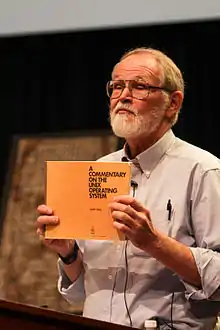 | Brian Kernighan | Helped to create Unix, AWK, AMPL and authored along with Dennis Ritchie influential The C Programming Language book. |
| Claire F. Gmachl | Developed novel designs for solid-state lasers leading to advances in the development of quantum cascade lasers. | |
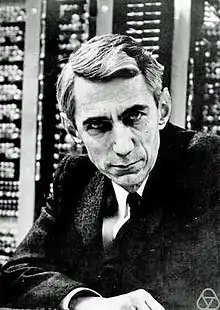 | Claude Shannon | Founded information theory with the publishing of A Mathematical Theory of Communication in 1948. He is perhaps equally well known for founding both digital computer and digital circuit design theory in 1937, when, as a 21-year-old master's degree student at the Massachusetts Institute of Technology (MIT), he wrote his thesis demonstrating that electrical applications of Boolean algebra could construct any logical, numerical relationship.[103] Shannon contributed to the field of cryptanalysis for national defense during World War II, including his basic work on codebreaking and secure telecommunications. For two months early in 1943, Shannon came into contact with the leading British cryptanalyst and mathematician Alan Turing. Shannon and Turing met at teatime in the cafeteria.[104] Turing showed Shannon his 1936 paper that defined what is now known as the "Universal Turing machine";[105][106] this impressed Shannon, as many of its ideas complemented his own. |
 | Clinton Davisson | Davisson and Lester Germer performed an experiment showing that electrons were diffracted at the surface of a crystal of nickel. This celebrated Davisson-Germer experiment confirmed the de Broglie hypothesis that particles of matter have a wave-like nature, which is a central tenet of quantum mechanics. Their observation of diffraction allowed the first measurement of a wavelength for electrons. He shared the Nobel Prize in 1937 with George Paget Thomson, who independently discovered electron diffraction at about the same time as Davisson. |
| Clyde G. Bethea | ||
| Corinna Cortes | Head of Google Research, New York. | |
 | Daniel Tsui | Along with Robert Laughlin and Horst Störmer discovered new form of quantum fluid. |
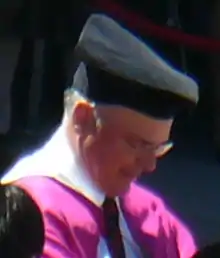 | David A. B. Miller | |
| Dawon Kahng | Invented the MOSFET (metal–oxide–semiconductor field-effect transistor) with Mohamed M. Atalla in 1959.[38][107] It revolutionized the electronics industry,[108][109] and is the most widely used semiconductor device in the world.[110][111] | |
 | Dennis Ritchie | Created the C programming language and, with long-time colleague Ken Thompson, the Unix operating system. Received the * National Medal of Technology (1998) with Ken Thompson, presented by President William Clinton. |
| Donald Cox | Received the IEEE Alexander Graham Bell Medal (1993) | |
| Donald P. Ling | Staff at BTL. In 1954, co-author of "Command Guidance for a Ballistic Missile." Vice president of Bell Labs and, in 1970, president of Bellcom, Inc. Retirement was 1971. | |
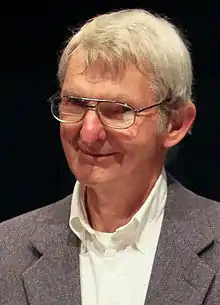 | Douglas McIlroy | Proposed Unix pipelines and developed several Unix tools. Pioneering researcher of macro processors, code reuse and component-based software engineering. Participated in the design of multiple influential programming languages, particularly PL/I, SNOBOL, ALTRAN, TMG and C++. |
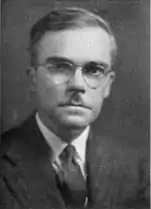 | Edward Lawry Norton | Famous for Norton's theorem. |
| Elizabeth Bailey | Worked in technical programming at Bell Laboratories from 1960 to 1972, before transferring to the economic research section from 1972 to 1977. | |
| Eric Betzig | An American physicist who worked to develop the field of fluorescence microscopy and photoactivated localization microscopy. He was awarded the 2014 Nobel Prize in Chemistry for "the development of super-resolved fluorescence microscopy" along with Stefan Hell and fellow Cornell alumnus William E. Moerner. | |
 | Eric Schmidt | Did a complete re-write with Mike Lesk of Lex, a program to generate lexical analysers for the Unix computer operating system. |
| Erna Schneider Hoover | Invented the computerized telephone switching method. | |
| Esther M. Conwell | Studied effects of high electric fields on electron transport in semiconductors, member of the National Academy of Engineering, National Academy of Sciences, and the American Academy of Arts and Sciences. | |
| Evelyn Hu | Pioneer in the fabrication of nanoscale electronic and photonic devices. | |
| Everett T. Burton | Time Division Multiplexing: Patent US2917583A Time separation communication system. | |
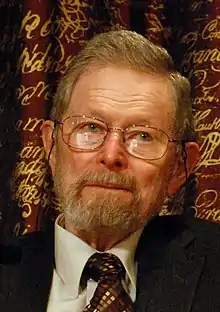 | George E. Smith | Led research into novel lasers and semiconductor devices. During his tenure, Smith was awarded dozens of patents and eventually headed the VLSI device department. George E. Smith shared the 2009 Nobel Prize in Physics with Willard Boyle for "the invention of an imaging semiconductor circuit—the CCD sensor, which has become an electronic eye in almost all areas of photography".[112] |
| Gil Amelio | Amelio was on the team that demonstrated the first working charge-coupled device (CCD). Worked at Fairchild Semiconductor, and the semiconductor division of Rockwell International but is best remembered as a CEO of National Semiconductor and Apple Inc. | |
| Harvey Fletcher | As Director of Research at Bell Labs, he oversaw research in electrical sound recording, including more than 100 stereo recordings with conductor Leopold Stokowski in 1931–1932.[113][114] | |
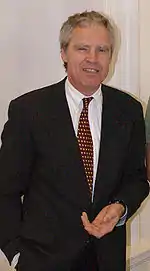 | Horst Ludwig Störmer | Along with Robert Laughlin and Daniel Tsui discovered new form of quantum fluid. |
| Howard M. Jackson II | Electrical engineer at Western Electric Co. where he worked in a manufacturing group of equipment for USAF bombing navigation systems. Employment for Bell Labs took him from Whippany, NJ, to Kwajalein, Marshall Islands, Naperville, IL, and back to Murray Hill, NJ. Worked mainly on computer technology including early missile detection software for Safeguard Anti-Ballistic Missile systems.[115] | |
 | John Hopcroft | Received the Turing Award jointly with Robert Tarjan in 1986 for fundamental achievements in the design and analysis of algorithms and data structures. |
| Ian Munro Ross | ||
.jpg.webp) | Ingrid Daubechies | Developed the orthogonal Daubechies wavelet and the biorthogonal Cohen–Daubechies–Feauveau wavelet. She is best known for her work with wavelets in image compression (such as JPEG 2000) and digital cinema. |
| James West | Joined Bell Telephone Laboratories in 1957 and holds more than 250 U.S. and foreign patents. One important patent is foil electret microphone with Gerhard M. Sessler.[116] | |
| Jeffrey Ullman | Advanced compiler theory and wrote the well known Dragon Book with Alfred Aho on compiler design. | |
| Jessie MacWilliams | Developed the MacWilliams identities in coding theory. | |
| John Mashey | Worked on the PWB/UNIX operating system at Bell Labs from 1973 to 1983, authoring the PWB shell, also known as the "Mashey Shell".[117] | |
| John M. Chambers | Developed the statistical programming language S, which is the forerunner to R. | |
 | John Bardeen | With William Shockley and Walter Brattain, the three scientists invented the point-contact transistor in 1947 and were jointly awarded the 1956 Nobel Prize in Physics. |
| Walter A. MacNair | Electrical engineer from 1929-1952. Also, worked at Consolidated Electrodynamics Corp. Associated with NASA projects as Aerospace Officials. | |
| Jon Hall | Executive Director of Linux International,[118] | |
| Ken Thompson | Designed and implemented the original Unix operating system. He also invented the B programming language, the direct predecessor to the C programming language, and was one of the creators and early developers of the Plan 9 operating systems. With Joseph Henry Condon he designed and built Belle, the first chess machine to earn a master rating. Since 2006, Thompson has worked at Google, where he co-invented the Go programming language. Received the * National Medal of Technology (1998) with Dennis Ritchie, presented by President William Clinton. | |
| Laurie Spiegel | Electronic musician and engineer known for developing the algorithmic composition software Music Mouse. | |
| Louis Brus | In 1972, began a 23 year career at AT&T Bell Labs in the studies of nanocrystals. Professor Emeritus at Columbia University. A 2023 Nobel Prize Laureate of Chemistry for quantum dots. | |
| Louis John Lanzerotti | Physicist with AT&T technical staff and Lucent Technologies Bell Labs, NASA Physical Science Committee, 1975 to 1979; Co-author of Diffusion in Radiation Belts. NASA’s Distinguished Public Service Award, 1988 and 1994. Who’s Who in America, 2000, 54th Ed. New Providence, NJ and Marquis Who’s Who, 1999. | |
| Margaret H. Wright | Pioneer in numerical computing and mathematical optimization, head of the Scientific Computing Research Department and Bell Labs Fellow, president of the Society for Industrial and Applied Mathematics. | |
| Marian Croak | ||
| Maurice Karnaugh | Famous for the Karnaugh map. | |
| Max Mathews | Wrote MUSIC, the first widely used program for sound generation, in 1957. | |
| Melvin J. Kelly | Research physicist, director of research in 1934, vice president in 1944, and president from 1951 to 1959. Focused on radar, gunfire control, and bombsights. Retired from BTL and became advisor to NASA Administrator James E. Webb in 1961. Deceased 1971. | |
 | Mohamed M. Atalla | Developed the silicon surface passivation process in 1957,[107][119] and then invented the MOSFET (metal–oxide–semiconductor field-effect transistor), the first practical implementation of a field-effect transistor, with Dawon Kahng in 1959.[108][109][110][111] This led to a breakthrough in semiconductor technology,[120][121] and revolutionized the electronics industry.[108][109] |
| Moungi Bawendi | Worked at Bell Labs as a summer hire. Louis Brus was his mentor at Bell Labs with nanocrystals. Bawendi's research lead to improved quality and production of quantum dots in 1993. A 2023 Nobel Prize Laureate of Chemistry for quantum dots. | |
| Narain Gehani | ||
| Narendra Karmarkar | Developed Karmarkar's algorithm. | |
| Neil deGrasse Tyson | Summer Intern at Murray Hill Bell Labs. American astrophysicist, author, and science communicator. | |
| Neil Sloane | Created the On-Line Encyclopedia of Integer Sequences. | |
| Osamu Fujimura | Japanese physicist, phonetician and linguist, recognized as one of the pioneers of speech science. Invented the C/D model of speech articulation. | |
 | Persi Diaconis | Known for tackling mathematical problems involving randomness and randomization, such as coin flipping and shuffling playing cards. |
 | Philip Warren Anderson | In 1977 Anderson was awarded the Nobel Prize in Physics for his investigations into the electronic structure of magnetic and disordered systems, which allowed for the development of electronic switching and memory devices in computers. |
| Phyllis Fox | Co-wrote the DYNAMO simulation programming language, principal author of the first LISP manual, and developed the PORT Mathematical Subroutine Library. | |
| Richard Hamming | Created a family of mathematical error-correcting code, which are called Hamming codes. Programmed one of the earliest computers, the IBM 650, and with Ruth A. Weiss developed the L2 programming language, one of the earliest computer languages, in 1956. | |
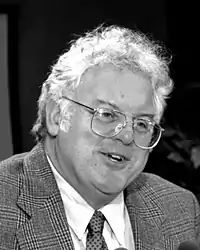 | Robert Laughlin | Along with Horst Störmer and Daniel Tsui discovered new form of quantum fluid. |
| Robert W. Lucky | ||
| Rob Pike | A member of the Unix team and was involved in the creation of the Plan 9 and Inferno operating systems, as well as the Limbo programming language. Co-authored the books The Unix Programming Environment and The Practice of Programming with Brian Kernighan. Co-created the UTF-8 character encoding standard with Ken Thompson, the Blit graphical terminal with Bart Locanthi Jr. and the sam and acme text editors. Pike has worked at Google, where he co-created the Go and Sawzall programming languages. | |
 | Robert Tarjan | Received the Turing Award jointly with John Hopcroft in 1986 for fundamental achievements in the design and analysis of algorithms and data structures. |
| Robert H. "Bob" Shennum | He led the satellite design and launch of Telstar I and II at Bell Labs of New Jersey. Directed the research labs for the next 31 years, started 1954, after his Ph.D. in physics and electrical engineering from California Institute of Technology. During the 60s and 70s lead research units for microwave radio design, mathematical analysis and digital systems design. He managed development of SAFEGUARD missile systems and a lab to research and develop new sources of power. In 1974, received the U.S. Army Citation for Patriotic Civilian Service for his contribution to the SAFEGUARD ABM missile systems. This military work would be from the North Carolina Labs.[122] | |
| Robert W. Wilson | Discovered background radiation, with Arno Allan Penzias, originating from the Big Bang and won the Nobel Prize in 1978 for that. | |
| Ron Brachman | Later was Director of Artificial Intelligence at DARPA.[123] | |
| Sharon Haynie | Developed DuPont's bio-3G product line and adhesives to close wounds. | |
| Shirley Jackson | Started in Bell Telephone Laboratories in 1976 as the first African American female with a physics PH.D.. Worked on several areas of theoretical physics that were ground breaking.[116] | |
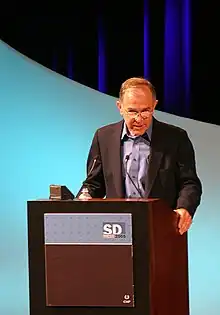 | Steve Bourne | Created the Bourne shell and the adb debugger, and authored the book The Unix System. He also served as president of the Association for Computing Machinery (ACM) (2000–2002), was made a fellow of the ACM (2005), received the ACM Presidential Award (2008) and the Outstanding Contribution to ACM Award (2017). |
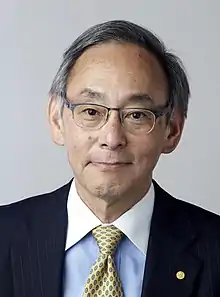 | Steven Chu | Known for his research at Bell Labs and Stanford University in cooling and trapping of atoms with laser light, which won him the Nobel Prize in Physics in 1997, along with his scientific colleagues Claude Cohen-Tannoudji and William Daniel Phillips.[124] |
| Steven Cundiff | Was instrumental in the development of the first frequency comb that led to one half of the 2005 Nobel prize.[125] Also made significant contributions to the ultrafast dynamics of semiconductor nanostructures, including the 2014 discovery of the dropleton quasi-particle.[126] | |
| Stuart Feldman | Creator of the computer software program make for Unix systems. He was also an author of the first Fortran 77 compiler, and he was part of the original group at Bell Labs that created the Unix operating system.[127] | |
| Thomas H. Crowley | Mathematician and AT&T executive, author of 1967 expository best seller "Understanding Computers". Executive director of the Safeguard anti-ballistic missile system software division of Bell Labs. Also, Bell Telephone Laboratories in Murray Hill, N.J. He earned several patents for his technical work, headed computer research departments at Bell Labs, including development and marketing of UNIX, and retired in 1985 as software vice-president, AT&T Information Systems.[128] | |
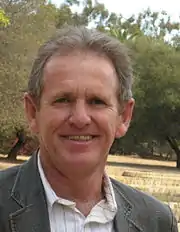 | Trevor Hastie | Known for his contributions to applied statistics, especially in the field of machine learning, data mining, and bioinformatics. |
| Vernon Stanley Mummert | ||
 | Walter Houser Brattain | With fellow scientists John Bardeen and William Shockley, invented the point-contact transistor in December 1947.[129] They shared the 1956 Nobel Prize in Physics for their invention. |
| Walter Lincoln Hawkins | Started in Bell Labs, developed sheathing. Polymer Cable Sheath Patent US 2,967,845 National Inventors Hall of Fame.[130] | |
| Warren P. Mason | Founder of distributed-element circuits, inventor of the GT quartz crystal, and many discoveries and inventions in ultrasonics and acoustics. | |
| James Wayne Hunt | Started in Bell Labs 1973. In May 1977, published the Hunt-Szymanski Algorithm paper which was an application example of the UNIX diff command.[130] | |
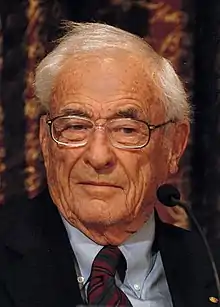 | Willard Boyle | Shares the 2009 Nobel Prize in Physics with George E. Smith for "the invention of an imaging semiconductor circuit—the CCD sensor, which has become an electronic eye in almost all areas of photography." |
| William O. Baker | ||
| William A. Massey | Bell Labs in 1977.[130] | |
| William B. Snow | Made major contributions to acoustics from 1923 to 1940. Fellow of the Audio Engineering Society (AES), received its Gold Medal Award in 1968. | |
 | William Shockley | With John Bardeen and Walter Brattain, the three scientists invented the point-contact transistor in 1947 and were jointly awarded the 1956 Nobel Prize in Physics. |
| Yann LeCun | Recognized as a founding father of convolutional neural networks and for work on optical character recognition and computer vision. He received the Turing Award in 2018 with Geoffrey Hinton and Yoshua Bengio for their work in deep learning. | |
| Yoshua Bengio | Received the Turing Award in 2018 with Geoffrey Hinton and Yann LeCun for their work in deep learning. | |
| Zhenan Bao | Development of the first all plastic transistor, or organic field-effect transistors which allows for its use in electronic paper.[131] |
Programs
On May 20, 2014, Bell Labs announced the Bell Labs Prize, a competition for innovators to offer proposals in information and communication technologies, with cash awards of up to $100,000 for the grand prize.[132]
Bell Labs Technology Showcase
The Murray Hill campus features a 3,000-square-foot (280 m2) exhibit, the Bell Labs Technology Showcase, showcasing the technological discoveries and developments at Bell Labs. The exhibit is located just off the main lobby and is open to the public.[133]
See also
- Bell Labs Holmdel Complex
- Bell Labs Technical Journal—Published scientific journal of Bell Laboratories (1996–present)
- Bell Labs Record
- Industrial laboratory
- George Stibitz—Bell Laboratories engineer—"father of the modern digital computer"
- History of mobile phones—Bell Laboratories conception and development of cellular phones
- High speed photography & Wollensak—Fastax high speed (rotating prism) cameras developed by Bell Labs
- Knolls Atomic Power Laboratory
- Simplified Message Desk Interface
- Sound film—Westrex sound system for cinema films developed by Bell Labs
- TWX Magazine—A short-lived trade periodical published by Bell Laboratories (1944–1952)
- Experiments in Art and Technology—A collaboration between artists and Bell Labs engineers & scientists to create new forms of art
References
- "Bell Telephone Laboratories". American Institute of Physics. Archived from the original on July 24, 2019. Retrieved June 9, 2019.
- "AT & T Bell Laboratories". American Institute of Physics. Archived from the original on July 11, 2019. Retrieved June 9, 2019.
- "Bell Labs Innovations". American Institute of Physics. Archived from the original on September 26, 2019. Retrieved June 9, 2019.
- "2018 Nobel Prize in Physics laureate Arthur Ashkin delivers his Nobel Lecture at Nokia Bell Labs". Nokia. Archived from the original on April 7, 2022. Retrieved April 9, 2020.
- 1634–1699: McCusker, J. J. (1997). How Much Is That in Real Money? A Historical Price Index for Use as a Deflator of Money Values in the Economy of the United States: Addenda et Corrigenda (PDF). American Antiquarian Society. 1700–1799: McCusker, J. J. (1992). How Much Is That in Real Money? A Historical Price Index for Use as a Deflator of Money Values in the Economy of the United States (PDF). American Antiquarian Society. 1800–present: Federal Reserve Bank of Minneapolis. "Consumer Price Index (estimate) 1800–". Retrieved May 28, 2023.
- Bruce, Robert V. Bell: Alexander Bell and the Conquest of Solitude. Ithaca, New York: Cornell University Press, 1990. ISBN 0-8014-9691-8.
- "Volta Bureau". National Historic Landmark summary listing. National Park Service. Archived from the original on October 11, 2012. Retrieved May 10, 2008.
- Unsigned (n.d.), National Register of Historic Places Inventory-Nomination: Volta Bureau, National Park Service, archived from the original on March 6, 2023, retrieved October 17, 2023 and Accompanying three photos, exterior, from 1972 (920 KB)
- "Volta Laboratory & Bureau". Washington D.C. National Register of Historic Places Travel Itinerary listing. National Park Service. Archived from the original on May 12, 2008. Retrieved May 10, 2008.
- Mackay, James (1997). Alexander Graham Bell, A Life. USA: John Wiley & Sons Inc.
- Garnet, Robert (1985). The Telephone Enterprise. Baltimore, Maryland: The Johns Hopkins University Press. pp. 1–44.
- "Nokia Bell Labs History". Nokia Bell Labs. July 20, 2018. Archived from the original on July 14, 2018. Retrieved July 21, 2018.
- Telephony, Volume 87(5), p.20, January 31, 1925
- Donofrio, Angelo (May–June 1966). "West Street Story". Bell Labs Reporter. 15.
- Gertner, Jon (2012). The Idea Factory. New York: The Penguin Press.
- Adams, Butler (1999). Manufacturing the Future. Cambridge: Cambridge University Press.
- "It's official! Bayer buys Alcatel-Lucent site in Hanover Twp". The Hanover Eagle. May 16, 2012. Archived from the original on March 24, 2016. Retrieved May 21, 2012.
- Kaysen, Ronda (September 11, 2013). "Future takes shape for Bell Labs site". The New York Times. Archived from the original on September 19, 2013. Retrieved September 29, 2013.
- "iCIMS Plans Move to Landmark Bell Works Building, Commits to Continued Growth in NJ". ICIMS.com. July 10, 2016. Archived from the original on July 10, 2018. Retrieved October 10, 2018.
- "Hundreds of new workers to move into historic Bell Labs building". NJ.com. April 10, 2017. Archived from the original on October 10, 2018. Retrieved October 10, 2018.
- "Chester Historical Society News & Views" (PDF). Historicchesternj.com. 2015. Archived (PDF) from the original on October 9, 2022. Retrieved July 26, 2022.
- Noll, A. Michael. "Memories : A Personal History of Bell Telephone Laboratories" (PDF). Quello.msu.edu. Archived (PDF) from the original on August 11, 2015. Retrieved July 26, 2022.
- "Bell Laboratories". Encyclopædia Britannica. Archived from the original on May 3, 2006.
- Leopold Stokowski, Harvey Fletcher, and the Bell Laboratories Experimental Recordings Archived December 27, 2019, at the Wayback Machine, Stokowski.org. Retrieved March 3, 2020.
- Copeland, Jack; Bowen, Jonathan (2017). "Chapter 1: Life and work & Chapter 18: Delilah—encrypting speech". The Turing Guide. Oxford University Press. ISBN 978-0198747833.
- Irvine, M. M. (July 2001). "Early digital computers at Bell Telephone Laboratories". IEEE Annals of the History of Computing. 23 (3): 22–42. doi:10.1109/85.948904. ISSN 1058-6180.
- Kaisler, Stephen H. (2016). "Chapter Three: Stibitz's Relay Computers". Birthing the Computer: From Relays to Vacuum Tubes. Cambridge Scholars Publishing. pp. 32–37. ISBN 9781443896313. Archived from the original on October 17, 2023. Retrieved January 17, 2019.
- Cesareo, O. (December 1946). "THE RELAY INTERPOLATOR". Bell Laboratories Record. XXIV (12): 457–460. Archived from the original on October 17, 2023. Retrieved September 8, 2018.
- Akera, Atsushi (2008). Calculating a Natural World: Scientists, Engineers, and Computers During the Rise of U.S. Cold War Research. MIT Press. p. 57. ISBN 9780262512039. Archived from the original on October 17, 2023. Retrieved January 17, 2019.
- Belzer, Jack; Holzman, Albert G.; Kent, Allen (1976). Encyclopedia of Computer Science and Technology: Volume 3 – Ballistics Calculations to Box–Jenkins Approach to Time Series Analysis and Forecasting. CRC Press. p. 197. ISBN 9780824722531. Archived from the original on October 17, 2023. Retrieved January 17, 2019.
- Glen G. Jr. Langdon (December 2, 2012). Logic Design: A Review Of Theory And Practice. Elsevier. p. 2. ISBN 9780323160452. Archived from the original on October 17, 2023. Retrieved January 17, 2019.
- "Model III computer. Frame with covers removed". The Erwin Tomash Library. n.d. Archived from the original on January 13, 2012.
- Juley, Joseph (January 1947). "THE BALLISTIC COMPUTER". Bell Laboratories Record. XXV (1): 5–9. Archived from the original on October 17, 2023. Retrieved September 8, 2018.
- Research, United States Office of Naval (1953). A survey of automatic digital computers. Model V-VI IV. Office of Naval Research, Dept. of the Navy. pp. 9–10, 63 (in reader: 15–16, 69).
- "Г. – Bell Labs – Model V" [G. – Bell Labs – Model V]. oplib.ru (in Russian). Archived from the original on October 12, 2017. Retrieved October 11, 2017.
- Reilly, Edwin D.; Ralston, Anthony; Hemmendinger, David (2000). Encyclopedia of Computer Science. Nature Publishing Group. p. 548. ISBN 9781561592487. Archived from the original on October 17, 2023. Retrieved January 17, 2019.
-
- Alt, Franz L. (1948). "A Bell Telephone Laboratories' computing machine. I". Mathematics of Computation. 3 (21): 1–13. doi:10.1090/S0025-5718-1948-0023118-1. ISSN 0025-5718.
- Alt, Franz L. (1948). "A Bell Telephone Laboratories' computing machine. II". Mathematics of Computation. 3 (22): 69–84. doi:10.1090/S0025-5718-1948-0025271-2. ISSN 0025-5718.
- "1960 – Metal Oxide Semiconductor (MOS) Transistor Demonstrated". The Silicon Engine. Computer History Museum. Archived from the original on March 8, 2021. Retrieved July 29, 2019.
- "Part I. HISTORY OF ABM DEVELOPMENT". Alternatewars.com. Archived from the original on April 16, 2014. Retrieved July 25, 2022.
- "Eyes Of A Generation…Television's Living History". Eyesofageneration.com. Archived from the original on December 26, 2022. Retrieved July 26, 2022.
- Iardella, Albert B. (1964). Western Electric and the Bell System-A SURVEY OF SERVICE (PDF). Western Electric Company. p. 20. Archived (PDF) from the original on September 5, 2020.
- Chang, Kenneth (August 31, 2020). "Myriam Sarachik Never Gave Up on Physics". The New York Times. ISSN 0362-4331. Archived from the original on August 31, 2020. Retrieved October 13, 2021.
- Banks, Michael, "Condensed-matter physics pioneer Philip Anderson dies aged 96 Archived March 31, 2020, at the Wayback Machine", Physics World, March 30, 2020
- "The Nobel Prize in Physics 1978". Nobelprize.org. Archived from the original on August 1, 2012. Retrieved February 24, 2011.
- "Baltimore Works". Archived from the original on November 27, 2022. Retrieved December 12, 2022.
- Fitchard, Kevin (November 23, 2021). "Meet the new Bell Labs Fellows". Archived from the original on July 28, 2022. Retrieved July 28, 2022.
- "Alcatel Lucent SA : Alcatel-Lucent's Bell Labs hosts event to explore the impact of software on society and to honor the life of Dennis Ritchie - the co-inventor of UNIX®". Marketscreener. September 5, 2012. Archived from the original on January 19, 2023. Retrieved January 1, 2023.
- "National Medal of Technology awarded". Chemical & Engineering News Archive. 63 (8): 8. February 25, 1985. doi:10.1021/cen-v063n008.p008. Archived from the original on January 19, 2023. Retrieved January 1, 2023.
- "The Rise of C++ – Bell Labs". Bell-labs.com. Archived from the original on June 30, 2017. Retrieved May 13, 2016.
- JANA, DEBASISH (October 1, 2014). C++ AND OBJECT-ORIENTED PROGRAMMING PARADIGM. PHI Learning Pvt. Ltd. ISBN 9788120350335. Archived from the original on October 17, 2023. Retrieved May 9, 2017.
- "The Nobel Prize in Physics 2018". NobelPrize.org. Archived from the original on February 9, 2019. Retrieved October 2, 2018.
- "Charles A. Burrus". Optica. September 17, 2021. Archived from the original on January 19, 2023. Retrieved January 1, 2023.
- US 4924492, Richard D. Gitlin; Sailesh K. Rao & Jean-Jacques Werner et al., "Wideband transmission of digital signals", published May 8, 1990, assigned to AT&T Corp
- "Bell Labs Luminaries Dennis Ritchie And Ken Thompson To Receive National Medal Of Technology". ScienceDaily. December 8, 1998. Archived from the original on April 16, 2002. Retrieved January 1, 2023.
- Snare, Ron C. (February 1978). "Common channel interoffice signaling: Peripheral maintenance and administration support system". The Bell System Technical Journal. 57 (2): 325–360. doi:10.1002/j.1538-7305.1978.tb02091.x. S2CID 35295557.
- US expired 5394437, Ender Ayanoglu; Nuri R. Dagdeviren & James E. Mazo et al., "High-speed modem synchronized to a remote CODEC", published February 28, 1995, assigned to AT&T Corp
- Winters, J.H.; Salz, J.; Gitlin, R.D. (February 1994). "The impact of antenna diversity on the capacity of wireless communication systems". IEEE Transactions on Communications. 42 (2/3/4): 1740–1751. doi:10.1109/TCOMM.1994.582882.
- Foschini, G.; Gans, M (1998). "On Limits of Wireless Communications in a Fading Environment when Using Multiple Antennas". Wireless Personal Communications. 6 (3): 311–335. doi:10.1023/A:1008889222784. S2CID 6157164.
- "The Dali Home Page". Archived from the original on January 16, 1997.
- Chuang, Tamara (January 19, 2023). "How Lucy Sanders tackles gender inequity: Data, research, humor". The Denver Post. Archived from the original on January 19, 2023. Retrieved January 1, 2023.
- "Profile: New Jersey Nanotechnology Consortium". Archived from the original on May 30, 2008.
- Cooper, Laura (January 31, 2019). "CACI International to Buy Private-Equity Backed LGS Innovations for $750 Million". Wall Street Journal. Archived from the original on June 22, 2020. Retrieved April 27, 2020.
- Jenifer Whalen (March 2000). "Interview with a Leader-IP Networking: Conduit to Cash" (PDF). Communications Technology. Archived (PDF) from the original on March 9, 2021. Retrieved August 2, 2022.
- Mike Dano (October 20, 2017). "Bell Labs: Cable/wireless convergence could cut expenses by 40%". Nobelprize.org. Archived from the original on August 3, 2022. Retrieved August 2, 2022.
- Geoff Brumfiel (2008). "Access : Bell Labs bottoms out : Nature News". Nature. 454 (7207): 927. doi:10.1038/454927a. PMID 18719552.
- Ganapati, Priya (August 27, 2008). "Bell Labs Kills Fundamental Physics Research". Wired. Archived from the original on August 28, 2008. Retrieved August 28, 2008.
- "The 2009 Nobel Prize in Physics – Press Release". Nobelprize.org. October 6, 2009. Archived from the original on May 16, 2012. Retrieved January 7, 2017.
- "Rob Soni Head of RAN Architecture, VMware Speaker BIO". 2022. Archived from the original on January 14, 2023. Retrieved January 14, 2023.
- "Gee Rittenhouse to take over as President of world-famous research institution Bell Labs" (Press release). Paris: Alcatel-Lucent. February 18, 2013. Archived from the original on March 13, 2016. Retrieved March 10, 2016.
- "Marcus Weldon appointed President of Alcatel-Lucent's Bell Labs to accelerate and unlock innovation as part of The Shift Plan" (Press release). Paris: Alcatel-Lucent. November 4, 2013. Archived from the original on July 13, 2015. Retrieved March 10, 2016.
- "Alcatel-Lucent sets new world record broadband speed of 10 Gbps for transmission of data over traditional copper telephone lines" (Press release). Paris: Alcatel-Lucent. July 9, 2014. Archived from the original on March 10, 2016. Retrieved March 10, 2016.
- "The Nobel Prize in Chemistry 2014". Nobel Media AB. 2014. Archived from the original on March 10, 2016. Retrieved March 10, 2016.
- "Nokia and Alcatel-Lucent Combine to Create an Innovation Leader in Next Generation Technology and Services for an IP Connected World" (Press release). Helsinki & Paris: Nokia. April 15, 2015. Archived from the original on April 16, 2015. Retrieved March 10, 2016.
- Scott, Mark; Jolly, David (April 15, 2015). "Nokia Agrees to $16.6 Billion Takeover of Alcatel-Lucent". The New York Times. Archived from the original on January 1, 2022. Retrieved March 10, 2016.
- "Nokia celebrates first day of combined operations with Alcatel-Lucent" (Press release). Espoo, Finland: Nokia. January 14, 2016. Archived from the original on March 9, 2016. Retrieved March 10, 2016.
- "Optical fiber transmits one terabit per second" (Press release). Technical University of Munich. September 16, 2016. Archived from the original on September 23, 2016. Retrieved September 23, 2016.
- "Bell Labs Fellow". Tampere University Research Portal. 2023. Archived from the original on January 14, 2023. Retrieved January 1, 2023.
- "Dragan Samardzija". Archived from the original on January 14, 2023. Retrieved January 14, 2023.
- 2021 Bell Labs Fellows award ceremony. Nokia Bell Labs. November 23, 2021. Archived from the original on June 5, 2022. Retrieved July 5, 2022 – via YouTube.
- "Accelerating a new era of research innovation at Nokia Bell Labs". Nokia Bell Labs. December 21, 2021. Archived from the original on February 14, 2023. Retrieved February 14, 2023.
- Heller, Aron (November 29, 2022). "Honoring the 2022 Bell Labs Fellows". Nokia Bell Labs. Archived from the original on January 14, 2023. Retrieved January 13, 2023.
- "Awards & Recognition – Bell Labs". Archived from the original on March 8, 2016. Retrieved March 8, 2016.
- "The Nobel Prize in Chemistry 2023". Archived from the original on October 6, 2023. Retrieved October 4, 2023.
- "Archived copy". Archived from the original on June 27, 2023. Retrieved October 4, 2023.
{{cite web}}: CS1 maint: archived copy as title (link) - O'Regan, Gerard (September 24, 2015). Pillars of Computing: A Compendium of Select, Pivotal Technology Firms. Springer. ISBN 9783319214641. Archived from the original on October 17, 2023. Retrieved November 8, 2020.
- "Richard W. Hamming - A.M. Turing Award Laureate". amturing.acm.org. Archived from the original on October 30, 2020. Retrieved February 3, 2019.
- "Kenneth Lane Thompson – A.M. Turing Award Laureate". amturing.acm.org. Archived from the original on October 20, 2021. Retrieved February 3, 2019.
- "Dennis M. Ritchie – A.M. Turing Award Laureate". amturing.acm.org. Archived from the original on October 20, 2021. Retrieved February 3, 2019.
- "Robert E Tarjan – A.M. Turing Award Laureate". amturing.acm.org. Archived from the original on October 30, 2017. Retrieved February 3, 2019.
- "John E Hopcroft – A.M. Turing Award Laureate". amturing.acm.org. Archived from the original on October 27, 2021. Retrieved February 3, 2019.
- "Nokia Bell Labs receives the 2020 Technology & Engineering Emmy® Award for pioneering work on imaging sensors". Bell-labs.com. October 20, 2020. Archived from the original on July 26, 2022. Retrieved July 26, 2022.
- "Alcatel-Lucent wins Emmy® Award for contributing to fundamental changes in how television is watched". Prnewswire.com (Press release). Archived from the original on May 25, 2022. Retrieved July 26, 2022.
- Nokia [@nokia] (January 28, 2021). "Proud to announce that The National Academy of Television Arts & Sciences granted a Technology & Engineering Emmy Award to the ISO Base Media File Format standardization, in which our multimedia research unit has played a major role. #video #nokiainnovates #techemmys @TheEmmys t.co/HCAHFDi4c3" (Tweet). Archived from the original on March 18, 2022. Retrieved July 5, 2022 – via Twitter.
- "Bell Telephone Monograph #1". 1920. Archived from the original on October 17, 2023. Retrieved March 20, 2022.
- Index of monographs. OCLC 2258253. Retrieved March 20, 2022 – via Worldcat.org.
- Barnaby J. Feder (August 13, 1981). "James Fisk, Bell Labs Executive And Leader In Radar, Dies At 70". The New York Times. Archived from the original on November 20, 2016. Retrieved January 31, 2017.
- "Thierry e Klein". July 22, 2021. Archived from the original on February 14, 2023. Retrieved February 14, 2023.
- "Peter Vetter". April 27, 2021. Archived from the original on February 14, 2023. Retrieved February 14, 2023.
- "Which Laboratory Boasts The Most Nobel Prize Winners?". Howtogeek.com. Archived from the original on December 30, 2016. Retrieved January 7, 2017.
- "Awards & Recognition – Bell Labs". Archived from the original on March 8, 2016. Retrieved March 8, 2016.
- U.S. Patent 3,731,000
- U.S. Patent 3,663,762
- Poundstone, William (2005). Fortune's Formula : The Untold Story of the Scientific Betting System That Beat the Casinos and Wall Street. Hill & Wang. ISBN 978-0-8090-4599-0.
- Hodges, Andrew (1992), Alan Turing: The Enigma, London: Vintage, pp. 243–252, ISBN 978-0-09-911641-7
- Turing, A.M. (1936), "On Computable Numbers, with an Application to the Entscheidungsproblem", Proceedings of the London Mathematical Society, 2 (published 1937), vol. 42, pp. 230–65, doi:10.1112/plms/s2-42.1.230, S2CID 73712
- Turing, A.M. (1938), "On Computable Numbers, with an Application to the Entscheidungsproblem: A correction", Proceedings of the London Mathematical Society, 2 (published 1937), vol. 43, no. 6, pp. 544–6, doi:10.1112/plms/s2-43.6.544
- Lojek, Bo (2007). History of Semiconductor Engineering. Springer Science & Business Media. pp. 120 & 321–3. ISBN 9783540342588.
- Chan, Yi-Jen (1992). Studies of InAIAs/InGaAs and GaInP/GaAs heterostructure FET's for high speed applications. University of Michigan. p. 1. Archived from the original on July 3, 2023. Retrieved July 29, 2019.
The Si MOSFET has revolutionized the electronics industry and as a result impacts our daily lives in almost every conceivable way.
- Grant, Duncan Andrew; Gowar, John (1989). Power MOSFETS: theory and applications. Wiley. p. 1. ISBN 9780471828679. Archived from the original on July 3, 2023. Retrieved July 29, 2019.
The metal–oxide–semiconductor field-effect transistor (MOSFET) is the most commonly used active device in the very large-scale integration of digital integrated circuits (VLSI). During the 1970s these components revolutionized electronic signal processing, control systems and computers.
- "Who Invented the Transistor?". Computer History Museum. December 4, 2013. Archived from the original on December 13, 2013. Retrieved July 20, 2019.
- Golio, Mike; Golio, Janet (2018). RF and Microwave Passive and Active Technologies. CRC Press. pp. 18–2. ISBN 9781420006728. Archived from the original on July 3, 2023. Retrieved July 29, 2019.
- Parry, Wayne (October 6, 2009). "3 Americans share 2009 Nobel physics prize". 6abc.com. Archived from the original on April 2, 2017. Retrieved January 7, 2017.
- Huffman, Larry. "Stokowski, Harvey Fletcher, and the Bell Labs Experimental Recordings". Stokowski.org. Archived from the original on November 28, 2010. Retrieved February 17, 2014.
- William Ander Smith, The mystery of Leopold Stokowski. Fairleigh Dickinson Univ Press, 1990, p.175.
- "Harold M. Jackson II - Hendersonville Lightning". Hendersonvillelightning.com. Archived from the original on August 13, 2022. Retrieved July 26, 2022.
- "Celebrating our impact, making a difference". February 3, 2020. Archived from the original on January 31, 2023. Retrieved December 20, 2022.
- Dolotta, T.A.; Haight, R.C.; Mashey, J.R. (July–August 1978). "The Programmer's Workbench" (PDF). Bell System Technical Journal. 57 (6 Part 2): 2177–2200. doi:10.1002/j.1538-7305.1978.tb02148.x. S2CID 21869088. Archived (PDF) from the original on October 9, 2022.
- "Linux International". Li.org. Archived from the original on August 4, 2015. Retrieved February 28, 2014.
- Bassett, Ross Knox (2007). To the Digital Age: Research Labs, Start-up Companies, and the Rise of MOS Technology. Johns Hopkins University Press. p. 46. ISBN 9780801886393. Archived from the original on February 2, 2023. Retrieved September 19, 2019.
- Huff, Howard (2005). High Dielectric Constant Materials: VLSI MOSFET Applications. Springer Science & Business Media. p. 34. ISBN 9783540210818. Archived from the original on October 17, 2023. Retrieved September 15, 2019.
- Sah, Chih-Tang (October 1988). "Evolution of the MOS transistor-from conception to VLSI" (PDF). Proceedings of the IEEE. 76 (10): 1280–1326 (1290). Bibcode:1988IEEEP..76.1280S. doi:10.1109/5.16328. ISSN 0018-9219. Archived (PDF) from the original on October 9, 2022.
Those of us active in silicon material and device research during 1956–1960 considered this successful effort by the Bell Labs group led by Atalla to stabilize the silicon surface the most important and significant technology advance, which blazed the trail that led to silicon integrated circuit technology developments in the second phase and volume production in the third phase.
- "Robert H. 'Bob' Shennum, 82". Dailyinterlake.com. January 20, 2005. Archived from the original on July 26, 2022. Retrieved July 26, 2022.
- "The Westfield Leader, OUR 115th YEAR - ISSUE NO. 07-2005" (PDF). Digifind-it.com. February 17, 2005. Archived (PDF) from the original on October 9, 2022.
- Tore Frängsmyr, ed. (1998). "Steven Chu Autobiography". The Nobel Prizes 1997. Les Prix Nobel. Stockholm: The Nobel Foundation. Archived from the original on June 6, 2013. Retrieved June 25, 2007.
- Jones, David J.; Diddams, Scott A.; Ranka, Jinendra K.; Stentz, Andrew; Windeler, Robert S.; Hall, John L.; Cundiff, Steven T. (April 28, 2000). "Carrier-Envelope Phase Control of Femtosecond Mode-Locked Lasers and Direct Optical Frequency Synthesis". Science. 288 (5466): 635–639. Bibcode:2000Sci...288..635J. doi:10.1126/science.288.5466.635. PMID 10784441. Archived from the original on June 26, 2022. Retrieved June 5, 2022.
- Almand-Hunter, A. E.; Li, H.; Cundiff, S. T.; Mootz, M.; Kira, M.; Koch, S. W. (February 27, 2014). "Quantum droplets of electrons and holes". Nature. 506 (7489): 471–475. Bibcode:2014Natur.506..471A. doi:10.1038/nature12994. PMID 24572422. S2CID 4453076.
- McIlroy, M. D. (1987). A Research Unix reader: annotated excerpts from the Programmer's Manual, 1971–1986 (PDF) (Technical report). CSTR. Bell Labs. 139. Archived (PDF) from the original on October 9, 2022.
- "Thomas H. Crowley Obituary (1924 - 2014) The Star-Ledger". Legacy.com. Archived from the original on November 16, 2022. Retrieved July 26, 2022.
- "Walter H. Brattain". IEEE Global History Network. IEEE. Retrieved August 10, 2011.
- Black Scientific Renaissance at Bell Labs at Morven 5.17.22 - intro: Shirley Satterfield. Morven Info. May 17, 2022. Archived from the original on May 25, 2022. Retrieved July 5, 2022 – via YouTube.
- Dagani, Ron (November 30, 1998). "An Innovation Engine for Lucent". Chemical & Engineering News. 76 (48): 24–28. doi:10.1021/cen-v076n048.p024.
- "Nokia Bell Labs Prize". Bell Labs. Archived from the original on March 17, 2017. Retrieved January 7, 2017.
- "Bell Labs Technology Showcase". Alchemystudio.com. Archived from the original on January 30, 2017. Retrieved January 7, 2017.
Further reading
- Martin, Douglas. Ian M. Ross, a President at Bell Labs, Dies at 85, The New York Times, March 16, 2013, p. A23
- Jon Gertner (2013). The Idea Factory: Bell Labs and the Great Age of American Innovation. ISBN 978-0143122791.
- Gleick, James. The Information: A History, a Theory, a Flood. Vintage Books, 2012, 544 pages. ISBN 978-1400096237.
External links
 Media related to Bell Labs at Wikimedia Commons
Media related to Bell Labs at Wikimedia Commons- Official website

- Bell Works, the re-imagining of the historic former Bell Labs building in Holmdel, New Jersey
- Timeline of discoveries as of 2006 <Nokia Bell-Labs Timeline>
- Bell Labs' Murray Hill anechoic chamber
- Bell Laboratories and the Development of Electrical Recording
- History of Bell Telephone Laboratories, Inc. (from Bell System Memorial)
- Bell Communications Around the Globe, public art sculpture, Los Angeles, California
- The Idea Factory – a video interview with Jon Gertner, author of "The Idea Factory: Bell Labs and the Great Age of American Innovation, by Dave Iverson of KQED-FM Public Radio, San Francisco

%252C_June_13%252C_2011.jpg.webp)